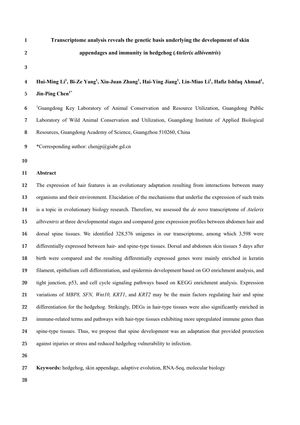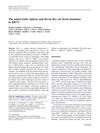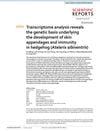Transcriptome Analysis Reveals the Genetic Basis Underlying the Development of Skin Appendages and Immunity in Hedgehog (Atelerix Albiventris)
May 2020
in “
bioRxiv (Cold Spring Harbor Laboratory)
”
keratin filament formation epithelial cell differentiation epidermis development tight junction p53 signaling pathway cell cycle signaling pathway MBP8 SFN Wnt10 KRT1 KRT2 immune-related pathways keratin epithelial cells epidermis tight junctions p53 cell cycle myelin basic protein 8 stratifin Wnt family member 10 keratin 1 keratin 2 immune pathways

TLDR The study found that certain genes are important for hedgehog skin appendage development and immunity, with spines possibly evolving for protection and infection resistance.
In the study, researchers analyzed the de novo transcriptome of the hedgehog species Atelerix albiventris at three developmental stages to understand the genetic basis of skin appendage development and immunity. They identified 328,576 unigenes and found 3,598 genes that were differentially expressed between hair and spine tissues. Gene Ontology (GO) enrichment analysis showed that genes differentially expressed in dorsal and abdomen skin tissues 5 days after birth were mainly involved in keratin filament formation, epithelial cell differentiation, and epidermis development. Additionally, KEGG enrichment analysis indicated that these genes were associated with tight junction, p53, and cell cycle signaling pathways. Key genes such as MBP8, SFN, Wnt10, KRT1, and KRT2 were suggested to play significant roles in regulating hair and spine differentiation. Notably, genes in hair-type tissues were also significantly enriched in immune-related terms and pathways, with hair-type tissues showing more upregulated immune genes than spine-type tissues. The study concluded that spine development in hedgehogs likely evolved as an adaptation for protection against injuries or stress and to reduce vulnerability to infection.



